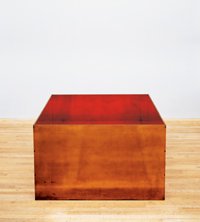Donald Judd
dal 1/10/2004 al 9/1/2005
Segnalato da
1/10/2004
Donald Judd
Kunstmuseum Basel, Basel
This first retrospective of the American artist Donald Judd's work since his death in 1994 brings together major work complexes from numerous American and European museums and private collections. On display will be some forty predominantly monumental and multi-part works created between 1961 and 1993.

An exhibition at the Kunstmuseum Basel and the Museum für Gegenwartskunst
This first retrospective of the American artist Donald Judd's work since his death in 1994 brings together major work complexes from numerous American and European museums and private collections. On display will be some forty predominantly monumental and multi-part works created between 1961 and 1993.
It is particularly appropriate that this exhibition, devised in conjunction with Tate Modern, London, and the Kunstsammlung Nordrhein-Westfalen, Düsseldorf, should be shown in Basel just now. The timing is ideal for a reappraisal and renewed discussion of the influential artistic oeuvre of this master of Minimal Art. The Kunstmuseum Basel was quick to champion Judd and built up an important work group around the seminal piece 'Untitled (six cold rolled steel boxes)', dating from 1969.
Born in Excelsior Springs, Missouri, in 1928, Judd started out as a painter. The exhibition begins at the Kunstmuseum with pictures from the early ‘60s, some of which have three-dimensional objects integrated into them to achieve non-illusionist spatial depth. In their compact materiality, these relief-like paintings project from the wall, ultimately liberating themselves from their vertical support to give way to free-standing works.
A noteworthy group of these handmade, oil-painted spatial volumes of wood, created between 1962 and 1964, already demonstrates Judd's development of a pioneering new vocabulary of reduced three-dimensional bodies. He subsequently went on to have such pieces fabricated – devoid of any trace of handcrafting – from industrial materials like galvanised iron, steel, copper, Plexiglas or plywood. Viewing his work as a total break with the European artistic tradition, Judd preferred to call his pieces – three-dimensional forms somewhere between traditional sculpture and architecture – 'specific objects', a term he introduced in an essay of the same name in 1964.
The focus of the exhibition is on Judd's famed wall-mounted and free-standing constellations of simple cubes and box shapes. Among the works on display are a singular floor box of amber Plexiglas with two lateral sheets of stainless steel and several series of standardised modules. The so-called 'stacks' are composed of identical box shapes projecting upwards into vertical space, the distance between them measuring the same dimensions as the elements themselves. 'Progressions', made from polished or brightly anodised aluminium, extend across a wall in extreme horizontality, varying intelligible arrangements of numerical sequences.
The rigorous structural clarity does not inhibit the complex interactions of open and closed volumes, interior and exterior forms, transparent and opaque surfaces. There is great sensual power in the activation of intervals, the architecture of a site and – most crucially – the viewer's perception.
When Judd created an 'outdoor sculpture' for the Sculpture in the 20th Century exhibition in Riehen's Merian Park in 1984, he had the bent, enamelled aluminium pieces for it produced in Switzerland – a first for him. The individual elements in sharply contrasting colours were visibly screwed together into a huge, hollow block. Mass and weight were replaced by construction and colour. This work, which is no longer extant, marked the beginning of a new colourism, highlighted in the second part of the exhibition at the Museum für Gegenwartskunst, where major free-standing and wall-mounted pieces from the ‘80s and early ‘90s create a fascinating interplay of sculptural volumes and architecture, material, colour and light.
From 1977 on, Donald Judd lived mainly in Marfa, Texas, where he had purchased land and a complex of buildings to enable him to install his work in ideal conditions and away from the hustle and bustle of the art world. It is in Marfa that the immense significance of space in Judd's art is truly revealed.
But Donald Judd was not only an artist. As an artist-critic, he observed a range of developments in American art with a keen analytical eye: above all the positions of Barnett Newman, Jackson Pollock, Jasper Johns, Dan Flavin and John Chamberlain. The works that the Kunstmuseum Basel and the Museum für Gegenwartskunst will be showing from their own collections in parallel to the Judd exhibition will allow visitors to discover illuminating artistic links.
B.M. Bürgi
The exhibition is supported by the Patronatskomitee Basler Kunstmuseen foundation and organised by Tate Modern. DuMont Literatur- und Kunstverlag has published a richly illustrated 280-page volume in German (English edition: Tate Publishing) with essays by David Batchelor, Rudi Fuchs, David Raskin, Nicholas Serota and Richard Shiff, plus a commented catalogue of the works on show and an extensive chronology.
Price: CHF 54.– / EUR approx. 37.–
Catalogue
Rémy Zaugg's List der Unschuld – Das Wahrnehmen einer Skulptur, about Donald Judd's 'Untitled (six cold rolled steel boxes)' of 1969, which was originally published in conjunction with the Documenta 1982 and has meanwhile become a standard reference, has also been reprinted.
Price: CHF 22.– / EUR approx. 15.–
Kunstmuseum Basel
St. Alban-Graben 16, CH-4010 Basel



